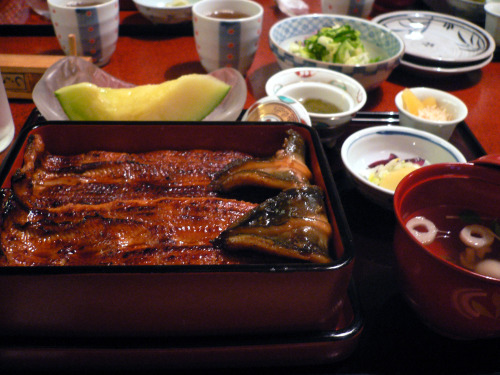It’s said that unagi (freshwater eel) has been consumed in Japan
since thousands of years ago. As it’s rich in protein, vitamin A and E,
and so on, it’s believed that unagi gives people stamina. For thisreason,
it’s eaten the most during the hottest time of the year in Japan. It’s a
Japanese custom to eat unagi on Doyo-no-ushinohi (the ox day during
Doyo period) in summer which fall between mid July and early August.
Filleted and deboned unagi is commonly glaze-grilled, and it’s called unagi-no-kabayaki. It’s skewered and grilled with sweet basting sauce, and is popularly served on top of steamed rice. Vacuum-sealed unagi-no-kabayaki is often available at Asian grocery stores.
Unagi-no-kabayaki is cooked differently in eastern Japan and western Japan. In eastern Japan, unagi is generally steamed after it is grilled, then it’s grilled again. In the western part of Japan, unagi isn’t usually steamed before grilling. So, unagi-no-kabayaki in eastern Japan is more tender than that in western Japan.
Filleted and deboned unagi is commonly glaze-grilled, and it’s called unagi-no-kabayaki. It’s skewered and grilled with sweet basting sauce, and is popularly served on top of steamed rice. Vacuum-sealed unagi-no-kabayaki is often available at Asian grocery stores.
Unagi-no-kabayaki is cooked differently in eastern Japan and western Japan. In eastern Japan, unagi is generally steamed after it is grilled, then it’s grilled again. In the western part of Japan, unagi isn’t usually steamed before grilling. So, unagi-no-kabayaki in eastern Japan is more tender than that in western Japan.
{source}

No comments:
Post a Comment